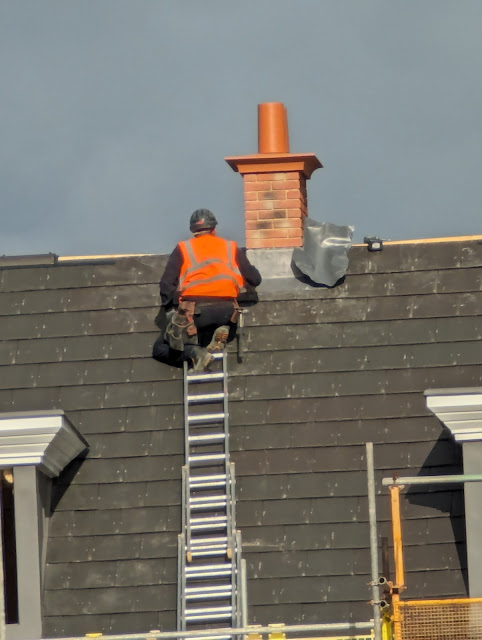 |
| Photo 1: Mobile Phone Development (1992 to 2014) |
Mobile phone development is another example of Moore's Law. I think my first mobile phone was probably the Nokia 3210 (3rd phone from the left). The era of 'smartphones' is also the history of Apple's i-Phone series that started in 2007. There have been many technological developments since then but the most significant has been the ubiquitous camera phone. With each new model, there have been improvements in picture resolution, addition of zoom and macro features, videoing, better low light performance, special effects and more. Now, apparently, artificial intelligence will make us better photographers.
My phone is a Google Pixel 7 Pro bought for a bargain price after the introduction of the Pixel 8 Series. I was out delivering some election leaflets last week and during my lunch break spotted someone working on a roof some distance away. So, out with the phone and I snapped this picture (Photo 2) ...
 |
| Photo 2: Person on Roof? |
Zooming in (5X optical), it clearly was a person working on the roof ...
Mary & I have lived through the technology age starting with the move away from slide rules and log tables to pocket calculators - some even had graphing capabilities! At University, we prepared punch cards for running small programs on the mainframe computer. And while I was doing my PhD in the mid-seventies, all my statistical analysis and reaction rate calculations were done on a Commodore Pet Computer which was state of the art in 1977.
Moving into the world of work (bp, 1980), it was a treat to work with Apple II and IIe PCs. In the 1980s, the personal computer for home use took off - examples included the Sinclair ZX Spectrum, the BBC Micro, the Commodore 128, the Amstrad CPC, etc. We took the plunge initially with a Dragon 64 and then an Atari ST. At work, we were using networked desktop PCs and laptops if you were working at home or away on business. Since about 2000, we have had Windows laptops (Sharp, Lenovo, Acer, Asus) for home use until moving over to Chromebooks about 10 years ago. We do, however, have a Windows 11 laptop used for specific tasks beyond the capabilities of our Chromebooks.
We have seen a lot of changes but the capabilities and features of modern camera phones still amaze. It is difficult to see how they can improve without phones getting ridiculously large. But I wouldn't bet against it: improving not getting larger.! Remember Moore's Law!!
By way of comparison, I did a quick comparison of the Pixel Pro 7 with my trusty Panasonic Lumix FZ38 (Photo 5). Although rather long in the tooth by today's standard this bridge camera is still a half decent performer with its 12 megapixel sensor and 18X optical zoom. I use it every day to take photos of the rear garden; for example, see here.
 |
| Photo 5: Panasonic FZ38 Bridge Camera |
Below is a series of photographs taken with the FZ38 at 1X, 5X and 18X optical zoom looking down the garden but focusing on the yellow bucket.
 |
| Photo 6: Yellow Bucket at 1X Optical Zoom (FZ38, 7.5 MB) |
 |
| Photo 7: Yellow Bucket at 5X Optical Zoom (FZ38, 7.4 MB) |
 |
| Photo 8: Yellow Bucket at 18X Optical Zoom (FZ38, 7.3 MB) |
A similar set of photos were taken with the Pixel 7 Pro using the 1X and 5X optical zoom and the 30X digital zoom. The photographs are similar rather than equivalent due to differences in the wide angle lenses and the aspect ratio of the picture.
 |
| Photo 9: Yellow Bucket at 1X Optical Zoom (Pixel 7 Pro, 5.1 MB) |
 |
| Photo 10: Yellow Bucket at 5X Optical Zoom (Pixel 7 Pro, 6.1 MB) |
 |
| Photo 11: Yellow Bucket at 30X Digital Zoom (Pixel 7 Pro, 2.0 MB) |
I still enjoy using my Lumix camera and, while it is extremely versatile and flexible in the types of pictures it can take, there is always the added faff of having to physically transfer the photos from the SD card to the computer/cloud. Its bulk is also a consideration when travelling.
A good camera phone has effectively replaced the compact camera due to the improvements in quality with the former. And, of course, nobody thinks twice about slipping their phone into a pocket/bag when they go out.
The camera phone is also pretty good in macro mode as Figures 12 & 13 illustrate. Which is fortunate as we do like to take close-ups of plants, butterflies and insects.
 |
| Figure 12: Lumix FZ38 in Macro Mode |
 |
| Figure 13: Pixel 7 Pro in Macro Mode |








0 comments:
Post a Comment